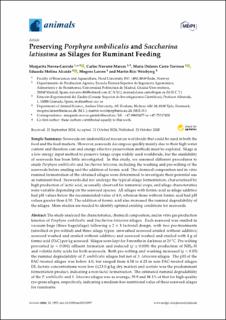Preserving Porphyra umbilicalis and Saccharina latissima as Silages for Ruminant Feeding
Novoa-Garrido, Margarita; Navarro Marcos, Carlos; Travieso Carro, Maria Dolores; Molina-Alcaide, Eduarda; Larsen, Mogens; Riis Weisbjerg, Martin
Peer reviewed, Journal article
Published version

View/
Date
2020Metadata
Show full item recordCollections
Original version
Novoa-Garrido, M., Marcos, C. N., Travieso, M. D. C., Alcaide, E. M., Larsen, M. & Weisbjerg, M. R. (2020). Preserving Porphyra umbilicalis and Saccharina latissima as silages for ruminant feeding. Animals, 10(11): 1957. doi: 10.3390/ani10111957Abstract
The study analyzed the characteristics, chemical composition, and in vitro gas production kinetics of Porphyra umbilicalis and Saccharina latissima silages. Each seaweed was ensiled in vacuum bags (three bags/silage) following a 2 × 3 factorial design, with two pre-treatments (unwilted or pre-wilted) and three silage types: unwashed seaweed ensiled without additive; seaweed washed and ensiled without additive; and seaweed washed and ensiled with 4 g of formic acid (FAC) per kg seaweed. Silages were kept for 3 months in darkness at 20 °C. Pre-wilting prevented (p < 0.001) effluent formation and reduced (p ≤ 0.038) the production of NH3-N and volatile fatty acids for both seaweeds. Both pre-wilting and washing increased (p < 0.05) the ruminal degradability of P. umbilicalis silages but not of S. latissima silages. The pH of the FAC-treated silages was below 4.0, but ranged from 4.54 to 6.23 in non FAC-treated silages. DL-lactate concentrations were low (≤23.0 g/kg dry matter) and acetate was the predominant fermentation product, indicating a non-lactic fermentation. The estimated ruminal degradability of the P. umbilicalis and S. latissima silages was as average, 59.9 and 86.1% of that for high-quality rye-grass silages, respectively, indicating a medium-low nutritional value of these seaweed silages for ruminants.
